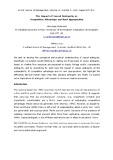- CERES Home
- →
- School of Management (SoM)
- →
- Staff publications (SoM)
- →
- View Item
JavaScript is disabled for your browser. Some features of this site may not work without it.
| dc.contributor.author | Ambrosini, Veronique | - |
| dc.contributor.author | Bowman, Cliff | - |
| dc.date.accessioned | 2013-02-13T23:01:52Z | |
| dc.date.available | 2013-02-13T23:01:52Z | |
| dc.date.issued | 2010-12-01T00:00:00Z | - |
| dc.identifier.citation | Véronique Ambrosini and Cliff Bowman, The Impact of Causal Ambiguity on Competitive Advantage and Rent Appropriation, British Journal of Management, Volume 21, Number 4, 2010, Pages 939–953. | |
| dc.identifier.issn | 1045-3172 | - |
| dc.identifier.uri | http://dx.doi.org/10.1111/j.1467-8551.2009.00644.x | - |
| dc.identifier.uri | http://dspace.lib.cranfield.ac.uk/handle/1826/7829 | |
| dc.description.abstract | We seek to develop the conceptual and practical understanding of causal ambiguity. Specifically we extend current thinking by setting out three types of causal ambiguity, based on whether firm resources are perceived to display linkage and/or characteristic ambiguity, and by examining for each type the impact of causal ambiguity on the sustainability of competitive advantage and on rent appropriation. We highlight the difficulties decision-makers face when they perceive ambiguity and finally we explore some implications of ambiguity with respect to resource-creation processes. | en_UK |
| dc.publisher | Blackwell Publishing Ltd | en_UK |
| dc.rights | The definitive version is available at www.blackwell-synergy.com | |
| dc.title | The Impact of Causal Ambiguity on Competitive Advantage and Rent Appropriation | en_UK |
| dc.type | Article | - |
Files in this item
This item appears in the following Collection(s)
-
Staff publications (SoM) [1258]
